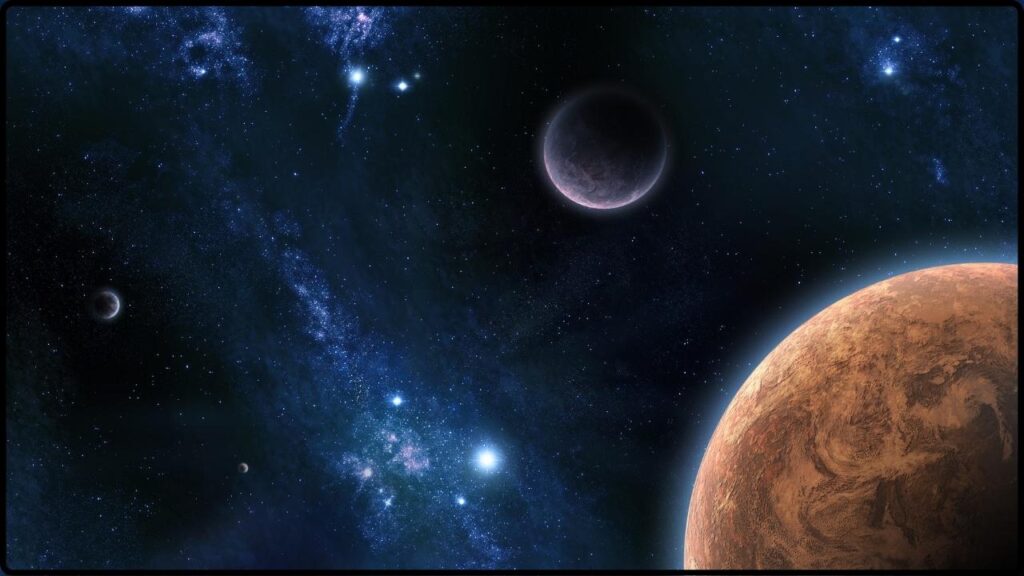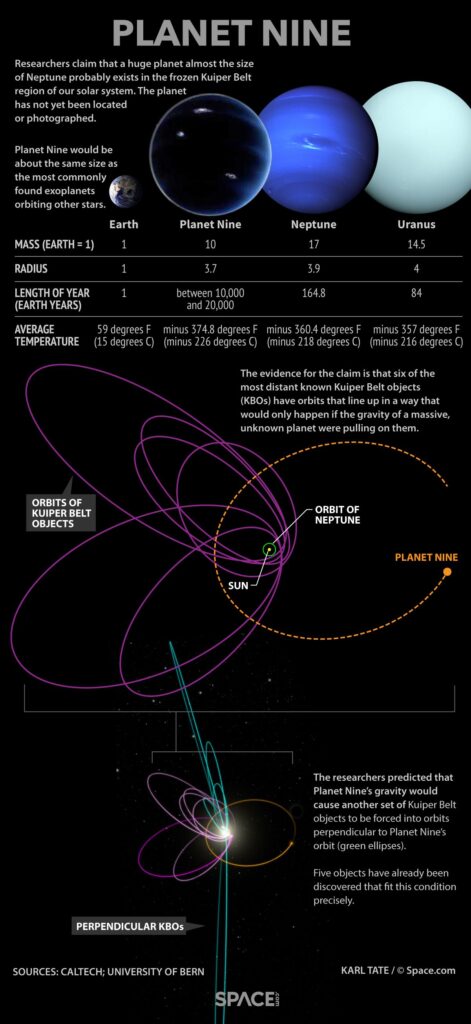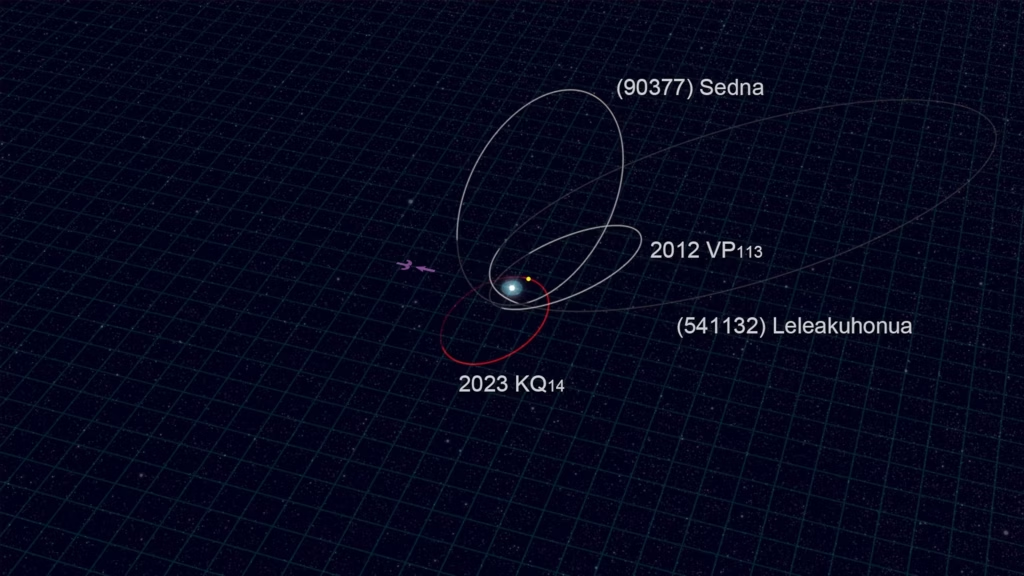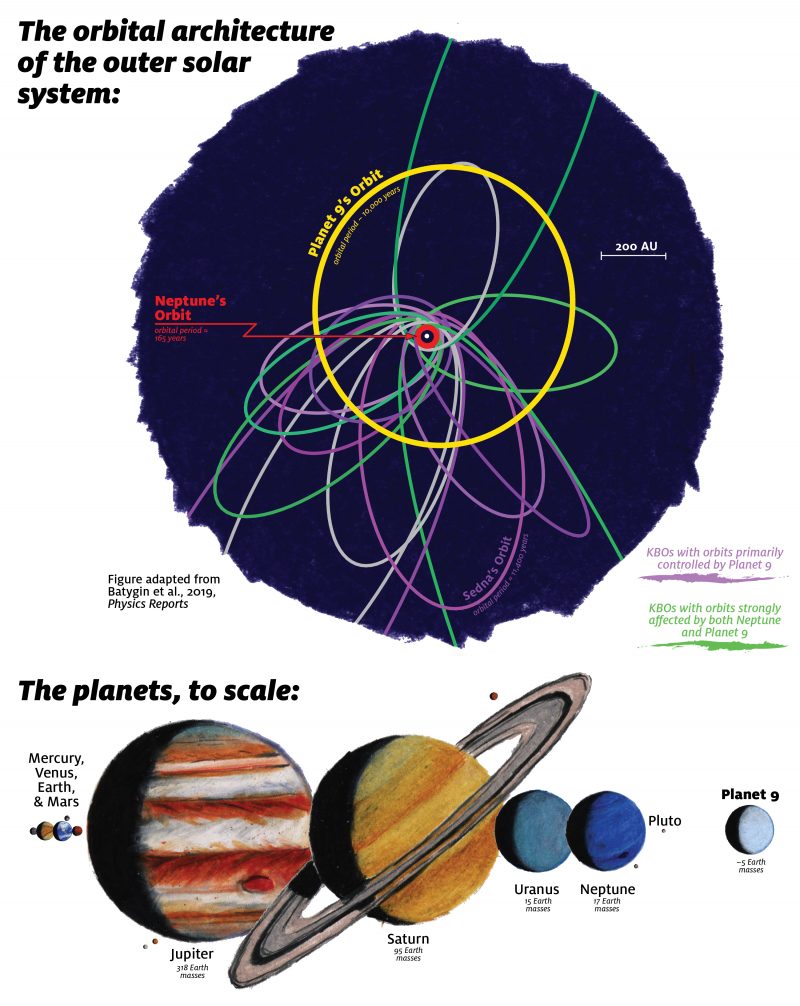
Goodbye Planet Nine Theory: The discovery of the object 2023 KQ14, also known as Ammonite, has scientists rethinking the entire theory of a “Planet Nine” in our solar system. For years, astronomers have speculated about the existence of an undiscovered planet lurking beyond Neptune. Some even suggested that this hypothetical planet could explain the unusual orbits of distant objects in our solar system. However, Ammonite’s unexpected orbit is forcing a closer look at these long-held theories. Could it be that we were wrong all along? In this article, we’ll dive into the fascinating details of 2023 KQ14, its orbit, and how its discovery might change everything we know about the solar system’s farthest reaches. Whether you’re a space enthusiast, a science professional, or just curious about the latest in astronomical research, this article is for you.
Goodbye Planet Nine Theory
The discovery of Ammonite (2023 KQ14) has forced scientists to rethink the idea of Planet Nine and reconsider the dynamics of the outer solar system. While there’s still much to explore, Ammonite’s unusual characteristics provide invaluable clues about the formation and evolution of our solar system’s farthest regions. Future research will continue to explore these questions, possibly leading to groundbreaking discoveries that change our understanding of the cosmos.
| Key Information | Details |
|---|---|
| Object Name | 2023 KQ14 (Ammonite) |
| Orbit | Highly elongated, with an eccentric path ranging from 65.9 to 438.1 AU from the Sun |
| Discovery | May 2023, by the Subaru Telescope as part of the FOSSIL survey |
| Orbit Period | 4,000 years |
| Apsidal Direction | Opposite direction compared to other sednoids |
| Potential Explanation | Disrupted orbit by a passing rogue planet or star (not Planet Nine) |
| Implications | Potential changes in understanding the outer solar system dynamics and the validity of the Planet Nine theory |
| Official Reference | 2023 KQ14 Wikipedia |
The Planet Nine Hypothesis: What We Thought We Knew
For nearly a decade, astronomers have been grappling with the idea of Planet Nine, an elusive, unseen planet that is thought to reside far beyond Neptune. Its existence was proposed to explain the peculiar orbits of certain trans-Neptunian objects (TNOs)—objects located beyond Neptune’s orbit. These objects have strange, aligned orbits that scientists believe might be the result of a large, invisible planet’s gravitational pull. But for years, despite a lot of speculation, no one could directly observe Planet Nine.
Scientists hypothesized that this planet, if it exists, would be roughly 10 times the mass of Earth, orbiting the Sun at an average distance of about 500 AU (astronomical units, with 1 AU being the distance from the Earth to the Sun). However, this theory has never been proven, and many astronomers have been skeptical of its existence.
That’s where Ammonite (2023 KQ14) comes into play.

Enter Ammonite: The New Kid in Town
In May 2023, the Subaru Telescope spotted a new object at the very edge of the solar system, which was quickly labeled 2023 KQ14. This object belongs to a rare class of distant solar system objects called sednoids, which follow orbits far beyond Neptune. But what makes Ammonite so different from other sednoids—and from what we expected—is the eccentricity and inclination of its orbit.
Ammonite’s Orbit: A Game Changer?
Ammonite follows an orbit that stretches from 65.9 AU to 438.1 AU from the Sun. This is an exceptionally elongated orbit, far more eccentric than that of the other known sednoids. Its semi-major axis—the average distance from the Sun—measures about 252 AU. For comparison, Neptune, the farthest planet from the Sun, sits at about 30 AU. To put it simply, Ammonite’s orbit is not just far, it’s a long shot—taking nearly 4,000 years to complete a single revolution around the Sun.
This is a pretty big deal. The sheer distance and duration of its orbit already set Ammonite apart from other known objects in the outer solar system. But what’s even more interesting is its inclination—the tilt of its orbit relative to the plane of the solar system. Ammonite’s orbit is tilted at 11 degrees, whereas most of the other distant objects in the solar system are aligned much closer to the ecliptic plane (the flat, disk-like plane in which most planets orbit).
The Apsidal Direction: A Clue to the Past
Ammonite’s apsidal direction—the line connecting the closest and farthest points of its orbit—points in the opposite direction compared to the three other known sednoids. The direction is at 271 degrees, whereas the other sednoids align between 0 and 90 degrees. This major orbital misalignment suggests that Ammonite may have had a different history compared to other distant objects in our solar system.
What Could Have Changed Its Orbit?
Ammonite’s strange orbit poses a big question: how did it end up like this? One possibility is that Ammonite’s orbit was once aligned with the other sednoids. However, something likely happened to disrupt this alignment. Some scientists believe that a passing rogue planet or even a star might have had a gravitational influence on Ammonite’s orbit, pulling it out of sync with its neighbors.
This theory challenges the existing idea that a distant Planet Nine is responsible for the unusual orbits of trans-Neptunian objects. If Ammonite’s orbit was disrupted by an external force—such as a passing star or rogue planet—then the Planet Nine theory might be less plausible than originally thought.

The Bigger Picture: Rethinking the Solar System’s Evolution
The discovery of Ammonite offers new insights into the solar system’s distant past. It suggests that the outer solar system may have been much more chaotic in its early years. Perhaps there was more planetary migration, with objects being ejected or having their orbits altered by forces outside of the known planets.
Could the solar system have once had a massive planet that was ejected from the system, or was there a gravitational encounter with a rogue star? These are questions scientists will need to answer in the coming years. But one thing is clear: Ammonite’s discovery is forcing astronomers to reconsider the stability and formation of the outer reaches of our solar system.
The Role of Technology: How We Found Ammonite
Ammonite’s discovery is a testament to the incredible advancements in space observation technology. Telescopes like Subaru have been key in uncovering distant objects, thanks to high-resolution imaging and the ability to track objects that are light years away. Over the years, tools like these have allowed astronomers to peer deeper into the solar system than ever before.
The FOSSIL survey, which discovered Ammonite, uses cutting-edge imaging technology that helps researchers find even the faintest and most distant objects, revolutionizing how we explore the solar system’s edge.
Additional Examples of Distant Objects: What We’ve Seen Before
Ammonite isn’t the first distant object to pique the interest of astronomers. Objects like Eris, Haumea, and Sedna have long been known for their eccentric orbits and have contributed to the broader understanding of the solar system’s distant regions. Sedna, for example, has a particularly long orbital period, taking over 11,000 years to complete its orbit, similar to the vast distances traveled by Ammonite.
These objects share many characteristics that challenge traditional understandings of the solar system, making them pivotal in shaping our knowledge of the outer solar system’s dynamics.
Implications for Future Space Missions
The discovery of objects like Ammonite opens up fascinating possibilities for future space missions. Spacecraft designed to reach the outer solar system could benefit from studying these mysterious bodies. Missions such as NASA’s New Horizons, which visited Pluto and beyond, might one day venture to distant objects like Ammonite, providing even more insights into the formation and evolution of the solar system.

The Future of Goodbye Planet Nine Theory: What’s Next?
So, what happens now with the Planet Nine theory? While the discovery of Ammonite doesn’t completely rule out the possibility of a distant planet, it certainly complicates the story. Ongoing observations of Ammonite, as well as further study of other distant objects in the solar system, will be crucial in determining whether Planet Nine exists or whether a new explanation is needed.
How Will Scientists Study It?
The next step for astronomers is to continue monitoring Ammonite’s movement and study its behavior over time. The hope is that by tracking its position and trajectory, scientists will be able to better understand how its orbit was altered and whether any external forces played a role. This will also help them refine our understanding of how other objects in the distant solar system have evolved.
Conclusion: What We’ve Learned and What’s Still to Come
Ammonite’s discovery is a game changer in the study of our solar system. It challenges the long-standing theory of Planet Nine and suggests that the outer solar system may have a more complex and dynamic history than we previously thought. Whether or not Planet Nine exists, Ammonite has opened up new avenues of research and has provided us with valuable insights into the solar system’s distant past.
Key Takeaways:
- Ammonite (2023 KQ14) has an exceptionally eccentric orbit, challenging the Planet Nine theory.
- Its orbit may have been altered by external forces like a rogue planet or star.
- The discovery raises important questions about the formation and stability of the outer solar system.
- Ongoing research and simulations will continue to shed light on these mysteries.
The Earth is No Longer Blue: NASA Reveals Shocking Climate Change Impact as Planet Turns Green
Biggest Piece of Mars Ever Found on Earth Just Sold for $5.3M — Guess Who Bought It
Zuckerberg Settles Massive Investor Lawsuit — How Much Will Meta Pay Out?











